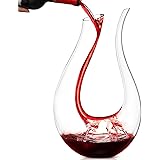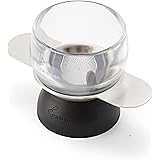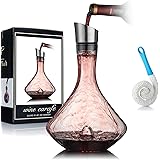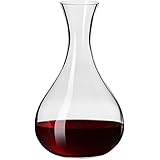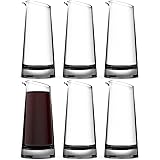The journey of wine appreciation extends far beyond the bottle itself; the vessel we choose can profoundly shape the experience. As Konstantin Baum, Master of Wine, embarks on another ultimate wine glass tasting, his focus shifts to a truly pivotal piece of stemware: the universal wine glass. This article expands upon the fascinating history and crucial tests presented in the accompanying video, delving deeper into why a single, versatile glass might be the ultimate solution for many wine lovers.
Discovering the Ultimate Universal Wine Glass: A Master of Wine’s Blind Test
For centuries, the wine glass has been an evolving companion to our most cherished beverage. Its form and function, far from static, tell a story of technological advancements, changing social customs, and a growing understanding of sensory science. Understanding this evolution helps us appreciate the modern quest for the perfect universal wine glass.
From Small Goblets to Sensory Instruments: The Evolution of Wine Glasses
The earliest known wine glasses, emerging from Venice in the 1400s, bore little resemblance to the delicate, expansive bowls we use today. These initial iterations were notably smaller, often thicker, and less clear. Glassmaking technology of the era simply did not permit the production of the fine, lightweight crystal we now take for granted.
Beyond technical limitations, historical drinking customs played a significant role. Until the mid-19th century, wine service was a transient affair. A server would present wine, the drinker would quickly consume it, and the glass would return to the server. This practice meant there was no practical need for a large, table-bound vessel.
A pivotal shift occurred around the middle of the 19th century, when it became customary to leave wine glasses on the table. This change necessitated larger capacities, as glasses were no longer refilled with every sip. However, despite their increasing size, these glasses remained primarily decorative; their design was not yet focused on enhancing the wine itself.
The 20th century ushered in a new era for stemware. Glasses grew considerably, and a wider array of shapes began to emerge. Leading this revolution was companies like Riedel, which pioneered the concept of varietal-specific glasses—stemware meticulously designed to accentuate the unique characteristics of particular grape varieties. This development transformed the wine glass from a mere container into a crucial instrument for sensory exploration.
Navigating the “Sea” of Stemware: The Case for a Universal Wine Glass
Today, the market presents an overwhelming “sea of different glasses” for every conceivable wine purpose. While the idea of matching a glass to a varietal holds considerable merit for dedicated enthusiasts, it also introduces significant complexity and cost. Owning a diverse collection of varietal-specific glasses, while ideal for some, becomes impractical for many, especially those who frequently taste multiple wines or simply lack storage space.
The wine glass industry, always eager to innovate, often promotes its newest creations with elaborate marketing claims. Terms like “maximizing the nose by re-harmonizing the aromas,” “tapering neck intensifies aroma molecules which are positively hurled out of the glass,” or “acts as a gentle decanter” are common. While some principles of glass shape influencing aroma and taste are scientifically sound, these hyperbolic claims sometimes border on the outrageous, making it challenging for consumers to discern genuine innovation from marketing hype.
This is where the universal wine glass offers a compelling alternative. For a Master of Wine like Konstantin, who might taste upwards of 100 different wines in a single session, constantly switching glasses is simply unfeasible. A high-performing universal glass provides consistency, convenience, and a reliable benchmark for evaluating diverse wines, regardless of their varietal or origin. It seeks to provide a balanced presentation for a wide spectrum of wines, rather than optimizing for just one.
The Blind Tasting Protocol: Unbiased Evaluation of Universal Wine Glasses
To identify the ultimate universal wine glass, Konstantin devised a rigorous blind tasting protocol. Objectivity is paramount in such tests, as visual cues and brand preconceptions can heavily influence perception. By donning a blindfold and having his wife randomize the glass presentation, Konstantin eliminated any potential biases. This approach ensures that only the sensory experience of the wine, as mediated by the glass, dictates the outcome.
The selection of test wines was equally strategic. To truly assess a glass’s universality, it must perform well across dramatically different wine styles. Konstantin chose two contrasting wines:
-
A Riesling from the Rheingau: This choice represents a delicate, aromatic white wine, typically characterized by high acidity, pronounced fruit (often citrus, stone fruit, or even petrol notes in aged examples), and a vibrant freshness. A good glass for Riesling should highlight its aromatic complexity and direct the wine smoothly to the mid-palate, where its acidity and fruit balance are best perceived.
-
A Red Wine from the South of France: In contrast, this selection brings a typically bolder, often more tannic, and fruit-driven red wine. Such wines frequently exhibit notes of dark berries, spices, herbs, and earthy undertones. For this style, an effective glass needs to allow ample aeration, soften tannins, and channel the wine to a broader area of the palate, permitting the full spectrum of its flavors and textures to emerge.
The glasses themselves represented a range in both price and design philosophy. From the accessible ISO wine glass, priced at 5 EUR and often used in professional wine education (like WSET courses), to the high-end Zieher Vision Straight at 50 EUR, the spectrum was wide. Other notable contenders included Konstantin’s current favorite, the Riedel Veritas Champagne glass, the newly acquired Riedel Performance Riesling glasses, Gabriel glass, Sophienwald, and Zalto.
White Wine Results: Highlighting Aromatics and Brightness
During the white wine round, Konstantin focused on how each glass presented the Riesling’s intricate aromatics and mouthfeel. Some glasses immediately stood out for their ability to elevate the fruit and freshness:
-
Riedel Veritas Champagne: This glass, already a personal favorite, proved its mettle once again. It effectively brought out the wine’s fruit and brightness, delivering a vibrant and expressive profile. Its design, while intended for Champagne, appears adept at concentrating delicate white wine aromas without overwhelming the palate.
-
Riedel Performance Riesling: As expected for a varietal-specific glass designed for this grape, it performed admirably, showcasing the wine’s characteristic citrus notes and overall brightness.
-
Gabriel Glass: A favorite among many wine connoisseurs, the Gabriel glass also delivered a compelling performance. Konstantin noted its ability to present the wine’s flavors as “intense and rich,” even with a delicate wine like Riesling.
In contrast, other glasses proved less effective. Some made the wine appear “hollow” or “less intense,” while one even caused the wine to “disappear.” These experiences highlight how a poorly designed glass can actively suppress a wine’s inherent qualities, masking its aroma and muting its flavor impact.
Red Wine Results: Complexity, Balance, and Structure
The second round, featuring the Southern French red wine, tested the glasses’ ability to handle bolder flavors, more structured tannins, and richer aromatic profiles. Konstantin observed that many of the glasses seemed to perform better with the red wine than with the white, suggesting that their shape might be more inherently suited to the characteristics of red varietals.
-
Riedel Veritas Champagne: Once more, this glass stood out, presenting the red wine with impressive richness and vibrancy, allowing fruit and spice notes to harmonize beautifully.
-
Riedel Performance Riesling: Unexpectedly for a Riesling-specific glass, it also delivered a strong performance with the red wine, showcasing a “good combo of fruit and spice notes.”
-
Gabriel Glass: This glass again excelled, presenting the wine as “very nice” with an “elevated” and “intense” flavor profile, demonstrating excellent balance and complexity.
-
Sophienwald and Zalto: These high-end glasses also made it into the winning lineup for the red wine, delivering a “complex, lifted, fresh, vibrant” experience. They are renowned for their delicate yet strong designs, often praised for their ability to transmit nuanced flavors.
Conversely, some glasses suppressed the red wine’s intensity, making it “slightly toned down” or causing the fruit flavors to “disappear.” One glass even unnaturally elevated specific notes like licorice and spice at the expense of overall fruitiness, creating an imbalanced profile.
The Triumphant Trio and the Doomed Glass
Through these rigorous blind tastings, a clear pattern emerged. Three glasses consistently delivered exceptional performance across both the delicate Riesling and the robust red wine:
-
Riedel Veritas Champagne Glass
-
Riedel Performance Riesling Glass
-
Gabriel Glass
These three truly represent strong contenders for the title of the ultimate universal wine glass. Their designs, while varied, share a common ability to allow both white and red wines to express their full potential, balancing fruit, acidity, tannins, and aromatic complexity. Konstantin, despite his current use of the Veritas Champagne, expressed interest in further exploring the Gabriel glass due to its impressive performance.
As for the worst performer, it was the small, traditional glass – the very one that embodied the older customs of wine service. Its diminutive size simply could not provide the necessary surface area for aeration or the bowl shape to concentrate aromas effectively. Its destruction, symbolic and decisive, paved the way for newer, more effective stemware in Konstantin’s collection.
Why Glass Shape Matters: Beyond Mere Containment
The reason behind these varying performances lies in the subtle yet profound impact of glass shape on the wine’s sensory presentation. A wine glass is not merely a container; it is an engineered instrument. Its bowl, rim, and stem work in concert to influence several critical aspects of the tasting experience:
-
Aroma Concentration: The shape of the bowl, particularly its widest point and the taper of the rim, controls how aromatic compounds rise and accumulate. A wider bowl allows for greater aeration, while a narrower opening concentrates these aromas, directing them more effectively to the nose. Imagine a wide, shallow puddle versus a narrow, tall cylinder; the latter channels vapors more intensely.
-
Aeration: The surface area of the wine exposed to air is crucial. A larger bowl allows more oxygen to interact with the wine, helping it “open up” and release its volatile aromatic compounds. This is akin to a decanter, which helps soften tannins in red wines and develop complex aromas.
-
Flow to the Palate: The rim diameter and curvature of the glass determine how the wine hits your palate. A wider rim might spread the wine across the entire tongue, emphasizing certain textures. A narrower rim can direct the wine to specific areas, accentuating sweetness, acidity, or fruitiness. It’s like guiding a stream of water to different parts of a garden.
-
Visual Appeal and Ergonomics: While less about taste, the clarity of the glass, the length of the stem, and the balance in hand contribute to the overall enjoyment. A clear, delicate glass allows you to appreciate the wine’s color and viscosity, while a stem prevents your hand from warming the wine.
These nuanced interactions explain why a particular universal wine glass can elevate or diminish a wine, making the choice of stemware a significant factor in unlocking wine’s full potential.
Beyond the Test: Choosing Your Own Universal Wine Glass
Konstantin’s test provides invaluable insights, but the ultimate choice of your personal universal wine glass might also come down to personal preference, budget, and practicality. The good news is that there are excellent options at various price points. Consider these factors when making your selection:
-
Budget: As seen, top performers range from moderately priced to premium. The ISO glass, despite its lower cost, is a perfectly functional starting point for an unpretentious tasting experience. However, investing a bit more in a Gabriel or a Riedel Veritas can elevate the sensory enjoyment considerably.
-
Durability: Fine crystal glasses, while enhancing the wine experience, are often delicate. If you prioritize robustness for everyday use or frequent washing, consider options made with lead-free crystal, which often offer a good balance of clarity, thinness, and strength.
-
Ergonomics: How does the glass feel in your hand? Is the stem comfortable to hold? Does it feel balanced? These tactile elements contribute significantly to the overall enjoyment of drinking wine.
-
Aesthetics: While taste is paramount, the visual appeal of a glass cannot be ignored. A beautifully designed glass can enhance the ritual of wine consumption and make a statement on your table.
Finding your perfect universal wine glass is a personal journey, but armed with insights from Master of Wine Konstantin Baum’s rigorous blind test, you are well-equipped to make an informed decision. Experimentation and personal tasting are key to discovering which glass best unlocks the magic in your chosen wines.


